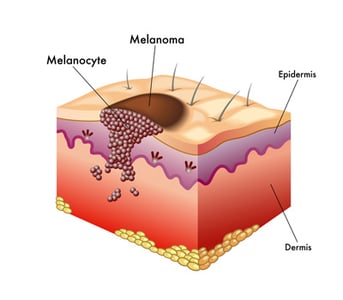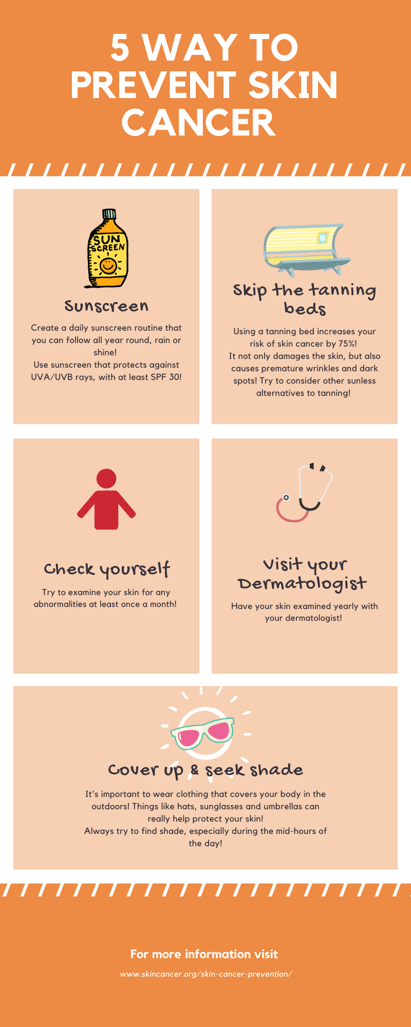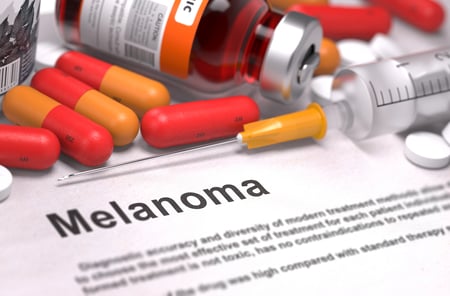Let's talk about it, the questions and answers to melanoma. Outlining what it is, how to prevent, and how to treat it.
Here at VLCM Foundation we like to have our donors choose from three specific areas of cancer research; melanoma, leukemia, and lung cancer. 100% of donations are then given to the Huntsman's Cancer Institute to research improvement in treatments, develop strategies to prevent diseases and so much more.
Over the the next few weeks we'll introduce all three types of cancer and hopefully answer some questions you didn't even know you had!
What is it?
 Melanoma is a form of skin cancer that is found in the melanocyte cells of the skin.
Melanoma is a form of skin cancer that is found in the melanocyte cells of the skin.
Melanocyte skin cells produce melanin, which give your skin it's color!
When your skin is exposed to harmful UV rays from the sun, or artificial rays (such as from tanning beds), it damages your skin which causes the melanocytes to produce above average melanin, this is what causes you to tan! That lovely golden color your skin gets from your tan is actually damage done to your skin and it's DNA. This damage causes changes and mutations in the melanocytes, resulting in uncontrolled cell growth and therefore, cancer.
However, melanoma can begin in other places in the body where there is pigmented tissue, not just the surface of the skin.
How to Prevent Melanoma & other Skin Cancers?

Melanoma is the fifth most common cancer among men and women. So prevention should always be your focus in reducing your chances of developing skin cancers. If found and treated early, chances for long-term survival are far higher rather than if found in later stages.
Now, we know it's important to check your body for any changes in your skin, but when examining what exactly are you looking for?
The ABC's of Melanoma is a really great tool in helping breakdown what signs you should look for while examining your body.
The information below was pulled from skincancer.org who have so much more information on types of skin cancer, the causes, treatments and more resources! Check them out, if you have more in-depth questions!
A is for Asymmetry. Most melanomas are asymmetrical. If you draw a line through the middle of the lesion, the two halves don’t match, so it looks different from a round to oval and symmetrical common mole.
B is for Border. Melanoma borders tend to be uneven and may have scalloped or notched edges, while common moles tend to have smoother, more even borders.
C is for Color. Multiple colors are a warning sign. While benign moles are usually a single shade of brown, a melanoma may have different shades of brown, tan or black. As it grows, the colors red, white or blue may also appear.
D is for Diameter or Dark. While it’s ideal to detect a melanoma when it is small, it’s a warning sign if a lesion is the size of a pencil eraser (about 6 mm, or ¼ inch in diameter) or larger. Some experts say it is also important to look for any lesion, no matter what size, that is darker than others. Rare, amelanotic melanomas are colorless.
E is for Evolving. Any change in size, shape, color or elevation of a spot on your skin, or any new symptom in it, such as bleeding, itching or crusting, may be a warning sign of melanoma.
How is Melanoma Treated?
Melanoma can be treated many different ways, of all depend on the stage, location, and you're overall health. Some ways Melanoma is treated are below:
- Surgery, for removal of the melanoma
- Immunotherapy
- Targeted therapy
- Chemotherapy
- Radiation

It's said that Melanoma caught at an early stage can be treated by an initial surgery. However, there's always a different plan for each person, to better fit their needs. If you have more questions or have concerns, please visit our friends at the Huntsman Cancer Institute as they're striving to not only make a difference for every patient, but also to make a difference in cancer research!
Sources
“About the Center.” About the Center - | University of Utah, 19 Aug. 2019, https://uofuhealth.utah.edu/huntsman/research-areas/disease-centers/melanoma/.
“Melanoma.” Melanoma Skin Cancer | Huntsman Cancer Institute, https://healthcare.utah.edu/huntsmancancerinstitute/skin-cancer/melanoma.php.
“Melanoma Warning Signs and Images.” The Skin Cancer Foundation, https://www.skincancer.org/skin-cancer-information/melanoma/melanoma-warning-signs-and-images/.
"Melanoma Overview." The Skin Cancer Foundation, https://www.skincancer.org/skin-cancer-information/melanoma/.
“Preventing Melanoma.” Centers for Disease Control and Prevention, Centers for Disease Control and Prevention, 2 June 2015, https://www.cdc.gov/vitalsigns/melanoma/index.html.

 0 Comments
0 Comments
